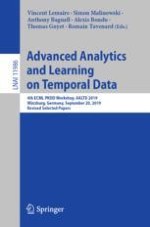This book constitutes the refereed proceedings of the 4th ECML PKDD Workshop on Advanced Analytics and Learning on Temporal Data, AALTD 2019, held in Würzburg, Germany, in September 2019.
The 7 full papers presented together with 9 poster papers were carefully reviewed and selected from 31 submissions. The papers cover topics such as temporal data clustering; classification of univariate and multivariate time series; early classification of temporal data; deep learning and learning representations for temporal data; modeling temporal dependencies; advanced forecasting and prediction models; space-temporal statistical analysis; functional data analysis methods; temporal data streams; interpretable time-series analysis methods; dimensionality reduction, sparsity, algorithmic complexity and big data challenge; and bio-informatics, medical, energy consumption, on temporal data.
